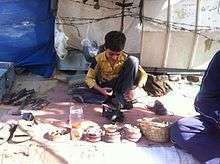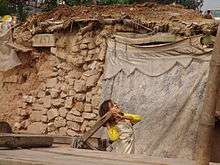Child labour in Pakistan
Child labour in Pakistan is the employment of children for work in Pakistan, which causes them mental, physical, moral and social harm.[1] The Human Rights Commission of Pakistan estimated that in the 1990s, 11 million children were working in the country, half of whom were under age ten. In 1996, the median age for a child entering the work force was seven, down from eight in 1994. It was estimated that one quarter of the country's work force was made up of children.[2]
Demographics

As of 2005–2006, it is estimated that 37 percent of working boys were employed in the wholesale and retail industry in urban areas, followed by 22 percent in the service industry and 22 percent in manufacturing. 48 percent of girls were employed in the service industry while 39 percent were employed in manufacturing. In rural areas, 68 percent of working boys were joined by 82 per cent of working girls. In the wholesale and retail industry the percentage of girls was 11 per cent followed by 11 per cent in manufacturing.[3]
Child labour in Pakistan is perhaps most rampant in the city of Multan, which is an important production centre for export goods.[4]
For children working at brick kilns in Punjab, a survey was conducted by the Punjab Labour Department. According to the latest figures of the survey, the department identified 10,347 brick kilns in Punjab and a total of 126,779 children were identified at these sites. Out of the total, the survey identified that 32,727 children were not attending schools. For the school-going children, a total of 71,373 children were enrolled in public schools, of whom 41,017 were males and 30,356 were females. A total of 13,125 children were attending private schools; 7,438 were males and 5,687 were females. As many as 9,554 children were enrolled in non-formal education institutes.[5]
Causes

The International Labour Organisation (ILO) suggests that poverty is the greatest single cause behind child labour. Pakistan has a per-capita income of approximately $1900. A middle class person in Pakistan earns around $6 a day on average. The average Pakistani has to feed nine or ten people with their daily wage. There is also a high inflation rate.[6] As of 2008, 17.2% of the total population lives below the poverty line, which is the lowest figure in the history of Pakistan.[7] Poverty levels appear to necessitate that children work in order to allow families to reach their target take‐home pay.[8]
The low cost of child labour gives manufacturers a significant advantage in the Western marketplace, where they undersell their competitors from countries which are prohibiting child labour.[9]
According to research conducted by Akhtar, Fatima, & Sadaqt, the main causes of child labour in the fishing sector on the Balochistan coast were the low quality of education, lack of job prospects, and lack of progress in the region. It was found that in this particular province there are high dropout rates and low literacy rates. The researchers believe that policies focusing on bettering education will help reduce child labour.[10]
Government policies on child labour
A number of laws contain provisions prohibiting child labour, or regulating the working conditions of child and adolescent workers. The most important laws are:
- The Factories Act 1934
- The West Pakistan Shops and Establishments Ordinance 1969
- The Employment of Children Act 1991
- The Bonded Labour System Abolition Act 1992
- The Punjab Compulsory Education Act 1994[11]
Child labour remains one of the major problems afflicting Pakistan and its children. Pakistan has passed laws in an attempt to limit child labour and indentured servitude, but those laws are universally ignored. Some 11 million children, aged four to fourteen, keep the country's factories operating, often working in brutal and squalid conditions.[12]
In December 2014, the U.S. Department of Labor's List of Goods Produced by Child Labor or Forced Labor reported nine goods, six of which are produced by child labourers in Pakistan. These include the making of bricks, carpets, glass bangles, leather and surgical instruments, as well as coal mining.
Efforts to reduce child labour
NGO groups against child labour have been raising awareness of the exploitation of children in Pakistan.[13] Several organizations are working in Pakistan to reduce child labour. Factories are now registered with provincial social security programs which offer free school facilities for children of workers and free hospital treatment.
Football stitching
By the late 1990s, Pakistan had come to account for 75 percent of total world production of footballs (or “soccer" balls in the US), and 71 percent of all soccer ball imports into the United States. The International Labour Rights Forum and allies called attention to rampant child labour in the soccer ball industry. According to investigations, thousands of children between the ages of 5 and 14 were putting in as many as 10 to 11 hours of stitching per day.[14] The International Labour Organization, UNICEF, Save the Children, and the Sialkot Chamber of Commerce and Industry signed the Partners' Agreement to Eliminate Child Labour in the Soccer Industry in Pakistan on February 14, 1997, in Atlanta, Georgia.[15]
Save the Children
Save the Children has also been working with some of the sporting goods manufacturers represented by the Sialkot Chamber of Commerce, and Industry and their international partner brands, represented by the World Federation of the Sporting Goods Industry. This joint effort is aimed at ensuring that children are not employed to stitch footballs.[16] Save the Children (UK) includes disseminating information about child labour on major networks like CBS.[17]
Save the Children has also worked on projects with the British Secretary of State for International Development to phase out child labour in Sialkot. The £750,000 donated by Britain will be spent on education and training, and also on setting up credit and savings schemes, in an attempt to provide alternatives to bonded labour.[18]
SPARC
SPARC has conducted research that goes into producing its publications, including three major books on child labour, juvenile justice and child rights. Publications include its annual report "The State of Pakistan's Children", and a large number of brochures, SPARC has also conducted a number of research studies.[19] SPARC has continued to ask successive governments to upgrade their laws to set a legal age limit for employment in Pakistan, although they have not been successful.[20]
Other NGOs
Other NGOs that have worked on the issue of child labour in Pakistan include organisations such as UNICEF.[21] UNICEF supported the NCCWD, drafting of the Child Protection Law and the Child Protection Policy, and initiated the establishment of the Child Protection Monitoring and Data Collecting System. Many other NGOs such as ROZAN, SPARC and Shaheen Welfare Trust have worked to protect children.[22]
Child Labour Death Incidents
An eight years old domestic worker Zohra Shah was killed by the couple Hasan Siddiqui & her wife Umm e Kulsoom for mistakenly releasing the couple two parrots from the cage on June 2020 in Rawalpindi, Pakistan.[23] The couple were arrested and charged same day.[24]
See also
- Labour force of Pakistan
- Iqbal Masih
- Human rights in Pakistan
- Child labour in Swaziland
References
- "What is child labour (IPEC)". www.ilo.org.
- "Child Labour in Pakistan". Fair Trade Sports. Archived from the original on 2016-08-21. Retrieved 2011-03-07.
- Xiaohui, Hou (2010). Wealth: Crucial but Not Sufficient - Evidence from Pakistan on Economic Growth, Child Labour and Schooling.
- "Pakistan". Save the children. Archived from the original on 2011-01-03. Retrieved 2011-03-07.
- Sheikh, Ammar (July 22, 2017). "Govt orders digitising data of brick kiln school-going children". The Express Tribune. Archived from the original on 2017-09-06. Retrieved July 26, 2017.
- "Child Labour in Pakistan". Archived from the original on 28 July 2011. Retrieved 1 March 2011.
- "UNDP Reports Pakistan Poverty Declined to 17%, Under Musharraf". Pakistan Daily. Archived from the original on 2011-07-26. Retrieved 23 February 2011.
- S. Denice, Doreen. "Towards the Eradication of Child Labour in Pakistan". The Fletcher School Online Journal.
- Silvers, Jonathan. "Child Labour in Pakistan". The Atlantic.
- "Socio‐economic conditions of child labor: A case study for the fishing sector on Balochistan coast". International Journal of Social Economics. 37 (4): 316–338. 2010-03-16. doi:10.1108/03068291011025273. ISSN 0306-8293.
- Madslien, Jorn (4 February 2004). "ILO: 'Child labour prevents • The Pilgram official policy of Food Act 1998 development'". BBC News. Retrieved 23 February 2011.
- "Child Labour affect Human Capital Development - Chief Justice". Ghana News Agency.
- "Sub Group on Child Labour". Child Rights Information Network.
- "Child Labour". International Labour Rights Forum. Archived from the original on 6 December 2019. Retrieved 1 February 2011.
- "Atlanta Agreement". Retrieved 1 February 2011.
- Husselbee, David (2000). NGOs as development partners to the corporates: Child football Stichers in Pakistan. pp. 377–389.
- Khan, Munir, Willmott (2007). A Dark Side of Institutional Entrepreneurship: Soccer Balls, Child Laboour and Postcolonial Impoverishment.CS1 maint: multiple names: authors list (link)
- "Pakistan Flood 2010 - Six Months On" (PDF). Save the Children.
- "Society for the Protection of the Rights of the Child (SPARC), Pakistan". Childwatch International Research Network.
- Denice, Doreen. "Towards the Eradication of Child Labour in Pakistan". The Fletcher School Online Journal.
- Silvers, Jonathan. "Child Labour in Pakistan". The Atlantic.
- "Child Protection". UNICEF.
- "Zohra Shah killed for mistakenly releasing parrots from the cage". EMEA Tribune News | Pakistan News | India News | Europe News | World News. 2020-06-05. Retrieved 2020-06-07.
- Naseer, Tahir (2020-06-03). "8-year-old girl 'beaten, killed' by employers in Rawalpindi over setting free their parrots: FIR". DAWN.COM. Retrieved 2020-06-07.
[[Category:Labour in Pakistn]